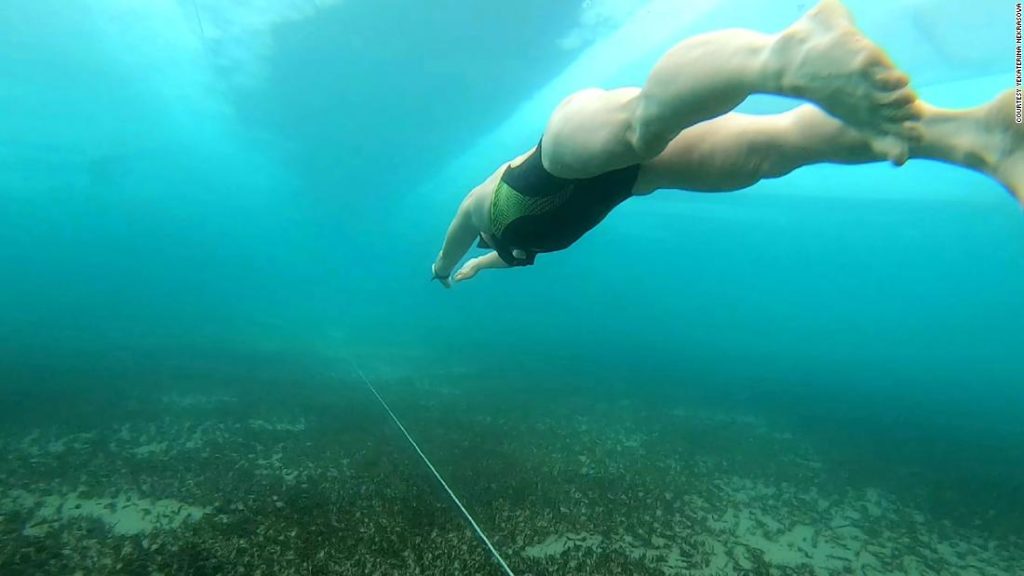Yekaterina Nekrasova, who took up free diving four years ago, then held her breath for a minute and a half as she covered the 85 meters (279 feet) of a frozen Lake Baikal on January 7 — the Russian Orthodox Christmas Day.
She is believed to have set a world record with her attempt. A spokeswoman for Guinness World Records told CNN they have received details of Nekrasova’s attempt but have yet to verify the landmark swim.
Footage filmed from above the surface shows members of her support team following behind in wet suits, in case of emergency. According to the Siberian Times, holes were cut in the 10-inch-thick ice at regular intervals in case she needed to abort the swim.
The challenge was filmed from both above and beneath the surface. Nekrasova can be seen descending a ladder, then following a route marked by a cable for a minute and a half. At the end she exits the water by climbing up another ladder.
Met by her support team, Nekrasova emerges to say in English: “I’m OK.”
Lake Baikal holds several global records itself. Somewhere between 20 and 25 million years old, it is the oldest existing freshwater lake on Earth. Reaching down as far as 5,315 feet, it is the deepest continental body of water, as well as being the world’s largest freshwater lake by volume — it holds about one-fifth of the fresh water on Earth’s surface, some 5,500 cubic miles.
While she knew that she could “comfortably” swim 75 meters (246 feet), Nekrasova said doubts began to creep in.
“I thought what if I would freeze before the start, or the mask would freeze or fog up, or I would stick to the ice at the finish line. And of course I didn’t know how long I could dive in a new place,” she wrote.
The air temperature was as low as -22 degrees Fahrenheit but felt more like -43.6 on January 6, she said. Conditions were “dangerous and dark under the ice,” which convinced the team to postpone the attempt.
Nekrasova described what happened the following day as a “Christmas miracle.”
“The weather warmed up to -21 (degrees Celsius, -5.8 Fahrenheit ), the wind slightly moderated,” she wrote. As her support team prepared the site with safety lanes and holes in the ice, she remained at her hotel.
Having warmed up, she made her way to the starting point, where she was joined by her support team.
“For a minute I stood dressed in front of the ladder, tuned in, breathing, the wind was strong. I put on a mask, undressed and hurried into the water. There is no wind, no frost, no fear in the water and it is very comfortable. I stood for about 30 seconds until the pulse calmed down. Then I dived.”
Describing the experience as a “pleasure,” said she “enjoyed the process” and that ultimately she was “overwhelmed with emotions.”
Signing off, she added: “The powerful energy of this place helped me. Thank you Baikal! Until next time!”
Ice swimming, or epiphany bathing, is a tradition in Russia. For many Orthodox Christians, it is part of a January ritual commemorating the baptism of Jesus.
Nekrasova, who trains four times a week in a warm pool and dives twice in a week in ice holes in Moscow, told CNN: “For me, under-ice diving is like an energy boost, as if I was reborn. It is a sensation I can’t compare to anything else, a very pleasant one. And I always long for it.”
By comparison, Nekrasova is a free diver — which means she held her breath for the duration of the swim at close to 32 degrees Fahrenheit, under a sheet of ice.
He said: “The water there is as fresh as one can get — salinity of zero. Meaning you are heavier in the water and you feel the cold a little more than in salt water.
“It is a magical place, Lake Baikal. The water visibility is also amazing, crystal clear water and you can see forever. That is a good factor for safety.”
Of Nekrasova’s achievement, he said: “The water should have been close to zero, which makes it extremely hard on your muscles. She swam without any assistance — gliding very efficiently. It was amazing to watch her.
“Eighty-five meters is a very long distance in warm water with no ice sheet above your head. Although she had a line to show her direction and distance, she wasn’t attached to anything, with few ice holes on the way. Typical hardcore Russian style.”
According to Guinness World Records, the record for the longest swim under ice is held by Dane Stig Severinsen, who swam 250 feet in Greenland in 2013.
You may also like
-
Super League: UEFA forced to drop disciplinary proceedings against remaining clubs
-
Simone Biles says she ‘should have quit way before Tokyo’
-
Kyrie Irving: NBA star the latest to withhold vaccination status
-
Roger Hunt: English football mourns death of Liverpool striker and World Cup winner
-
‘Every single time I lift the bar, I’m just lifting my country up’: Shiva Karout’s quest for powerlifting glory

